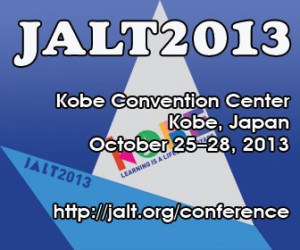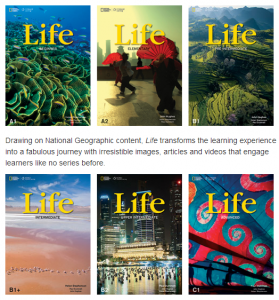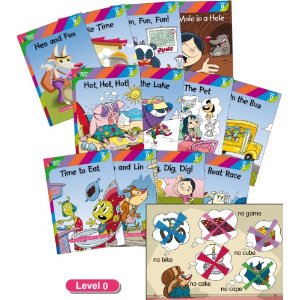JALT National Conference 2013
I was lucky enough to be able to attend the JALT National conference last week, held in Kobe.
I think this was my third JALT national conference, and strangely I think it was also the one I liked the most.
I say strangely because I actually came down with a bad cold on Thursday night, and spent much of my time in Kobe feeling hungover -despite not drinking a drop for the last couple of weeks! It was probably the least social conference performance I have put on for a while, only managing to speak to a few people and skipping all the social events.
The thing about JALT national is that it is so big that there is the potential to have all sorts of different experiences, depending on what you do and which sessions you go to. In the past I have felt the average quality of presentations at the national conference was not as high as the ones at smaller, more specialized conferences (like the Pan-SIG or the ER Seminar). There are also so many things going on (well over 20 simultaneous workshops in most time slots) that paralysis through too much choice is actually a real danger 🙂
So to sum up my experience of this year’s JALT national:
The Good
- Kobe was great. An attractive, convenient, interesting city.
- The venue was great too. Easy to get to and suited to purpose.
- The keynote speeches were great this year. I saw three of them. Interesting and thought-provoking.
- The cafe at the back of the EME was pretty good, fast and tasty (good iced coffee too).
- Keith Folse was fantastic. Great speaker, and I’m really glad to have found his textbooks (we’re talking about introducing a writing course at TU). Here’s a video of his keynote in Korea in 2011.
- The sessions I went to were almost all good.
- I did manage to meet some new people and talk to some people I hadn’t spoken to for a while.
The Bad
- Having a bad cold was not fun.
- My hotel, due to lack of planning on my part, was on a different island to the venue, resulting in a 40-minute, three-train commute each morning. Oops.
- The venue, while great, consisted of three buildings and it took me until the morning of the second day to get it straight in my head. Memo to self: go in on the Friday evening and figure out the venue.
- I don’t like paying 2000 yen to rent a projector for my presentation, especially when they belong to JALT and were bought with donations from the SIGs… on top of the not cheap fee to attend the confenrence seems a bit much.
- I missed a lot of people I had been wanting to talk to.
Things I learned
- Lots of assumptions I had about bilingualism might not be true. Need to do a lot of reading.
- Xreading has incredible potential. If they are able to do half of the things they are planning to, we might end up adopting their extensive reading system.
- The Great Writing series looks incredibly interesting.
- Communicating with parents may well be the key to a successful English school. Lots to work on.
- Cambridge English might be okay as private language schools go (I have doubts sometimes) 🙂
Overall
Despite worries about the typhoon and how it would affect flights, etc. and that damn cold, this was a very smooth and enjoyable conference. I had a great audience at my workshop and ended up learning several new, pertinent things over the three days of the conference. The organizers and volunteers should all feel very satisfied and proud of themselves.
Anyone else make it to JALT National this year? What good things did I miss?
language courses materials Review reviews textbooks
by sendaiben
leave a comment
Review: Life (4-skills series by Cengage)
After a long hiatus, a review. This textbook is for teenagers and adults.
Life is a 6-level, 4-skills series consisting of a student book, workbook, and teacher’s book at each level. The student book has a DVD with videos, and the teacher’s book contains two CDs with the class audio. The workbook also has a CD for listening-based homework. The series runs from Beginner (A1) to Advanced (C1).
First impression: Life is gorgeous. Cengage is really leveraging all those National Geographic photos they have access to, and it is working really well. If you are a Japan-based teacher you will probably be struck by how dense the book is -there is a lot on each page and much less white space than we are used to. Someone described it as a ‘European-style’ textbook, as opposed to ‘Asian-style’.
The Good
- This is a very attractive textbook. The design and production values are very high.
- There is a lot of content. Each book has 12 units, each unit has 6 sections. We’ve been working through one section per class so far.
- A really nice variety of topics and media (print. audio, video).
- There is a lot of variety. Reading, grammar, vocabulary, and speaking exercises on almost every page.
- The class audio is included in the teacher book. I like this idea a lot, rather than making us buy separate overpriced classroom CDs like many publishers do.
- The website actually seems to have useful materials on it 🙂
The Bad
- It’s expensive. All those production values come at a cost (EDIT: but there is a split edition I haven’t seen that incorporates half of the student book and workbook together).
- For Japanese students, it’s completely unbalanced. The grammar parts are way too easy, the reading/listening are too difficult.
- The dense page layouts can be intimidating (just a first impression problem).
Overall
I really like the series so far. We’re three weeks in and the students like it and are challenged by it, and it’s a fairly intuitive textbook from the teacher’s point of view. We’ve been using the Intermediate level with our ‘advanced’ high school student eikaiwa class, so I’m looking forward to using some of the other levels in due course. Recommended.
Building Blocks Library curriculum EFL eikaiwa ES extensive reading junior high school kids Language learning materials phonics readers Reading Review reviews teaching
by sendaiben
5 comments
Review of MPI’s Building Blocks Library
Full disclosure: I was asked to write some additional readers for this series last year, and they just came out. I’ll try not to be too gushy in this review.
The Building Blocks Library, published by Matsuka Phonics Institute, is a ten level series with 82 titles. The first four levels are written as phonics readers to help students start reading, the ones after that are leveled readers for extensive reading.
The good:
- The same characters appear in many of the books, developing throughout the levels
- Ten levels means that students can move up through the series gradually and read at their level
- The artwork and production values are high and the books are attractive
- Each level comes with a CD of the books read aloud: the CD is well made and the voice acting is good
- Most of the books are interesting with varied story lines
- The series is reasonably priced, especially considering they come with CDs
The bad:
- There are not enough books at each level to meet student needs (this has been partially addressed with the new Level 0 and Level 1A sets, but schools will still need to supplement this with other materials)
- The difficulty outstrips the content at the higher levels, ie they are difficult for ordinary junior high school students to read even though the stories probably appeal to students that age the most
Overall:
This is a very nicely produced series that appeals to students and is economical and easy to integrate for schools. The main drawback is that there are not enough books at each level to allow students to move up the levels smoothly -ideally students would be doing much more reading at each level before moving up so teachers will have to supplement this with other materials.
eikaiwa iPhone kids Language learning materials online resources personal Review school management technology
by sendaiben
2 comments
Nexus 7 Tablet Review
The Nexus 7 tablet by Google and Asus was finally released in Japan last month. I am a huge Google fan and am looking for alternatives to the iPad for the classroom. It was too good an excuse, so I went ahead and ordered one.
My wife has an iPad 2, and I will be comparing the Nexus 7 to that, as well as to my iPhone 4S. This is my first Android device.
In brief: it’s great. I really like the 7″ form factor. It feels much lighter and easier to hold than the iPad, and at just under 20,000 yen, it is less than half the price of the new retina iPad.
The good:
- size and weight are much more user-friendly than the iPad
- screen is good with internet, ebooks, and movies
- Android OS is fast and fairly intuitive
- 2000 yen credit for the Google Play Store
- One movie and three books included
- Lots of Japanese content on the Play store, including ebooks
- E-reader includes an easy to use J-E/E-J dictionary
- Skype is really easy to use
- Not as many apps as iOS
- No Flash support! This is huge, as most of the websites I want students to use with this (WordEngine, Starfall) are flash-based
- Not as intuitive as iOS in terms of navigation, etc.
Overall:
I love this tablet. For reading ebooks, watching movies, carrying around with me, reading PDFs, accessing the Google online world (gmail, reader, drive, etc.) it is wonderful. I’m really glad I got it, and it will supplement my iPhone 4S for most of these tasks.
However, unless I can get around the lack of Flash support (there seem to be workarounds for it, but they are not official and involve some risks) we won’t be buying these for students to use in class. It’s a shame, as the smaller and lighter form factor would make them easier to use for children than iPads.
Basically, if you use Google sites like gmail, drive, and reader, if you read ebooks and need a tablet to take movies and music on the road with you, this could be ideal. As a classroom tool it is crippled by the lack of Flash support.
Anyone else tried the Nexus 7?
EFL eikaiwa ES extensive reading kids language courses Language learning materials Penguin Kids Readers readers Reading Review reviews school management teaching
by sendaiben
4 comments
Penguin Kids Readers
Resuming our kids’ readers roundup after a brief hiatus 🙂
I received a set of these a couple of weeks ago from the publisher (thanks!). While I appreciate the gesture, it will not affect how I review them here.
Having said that, this is a fantastic new series that has a lot going for it. There are currently 23 readers over six levels of difficulty.
Level 1 (200 headwords)
Level 2 (400 headwords)
Level 3 (600 headwords)
Level 4 (800 headwords)
Level 5 (1000 headwords)
Level 6 (1200 headwords)
As you can see, the jump between levels is fairly minimal, something that is extremely important for beginner and younger readers.
The current titles are all based on Disney films, and the artwork and covers are beautiful. The writing isn’t bad, either, in that the books actually tell coherent stories. That is often a problem with low-level readers based on films or TV content -they try to fit in too much with a minimal wordlist so the stories end up not making sense. Luckily that is not the case here. In many of the books they have taken just one scene from a film and told that. Our students found the books really attractive due to the topics, but there was enough of a spread that they had not seen all of the movies featured.
Another thing I liked were the simple exercises in the back of the books. They have pre-reading and post-reading questions that are visual and fairly easy -perfect to do in class after reading or to check out of class reading. If anything, I would have liked to see this section be slightly longer.
Apparently the series will end up having twelve books at each level, and there will be different content in the next wave of books (ie not just Disney).
Overall, this is a fantastic new resource. We ended up ordering two more sets, and I’m really looking forward to the release of the rest of the books in this series.




